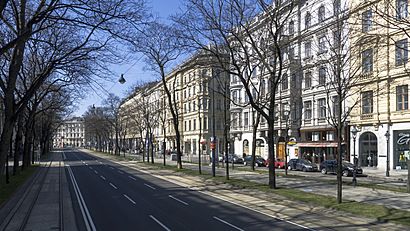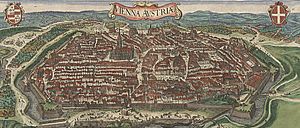Vienna Ring Road facts for kids
The Ringstrasse (which means ring road in German) is a large, circular road in Vienna, Austria. It goes around the historic city center, called the Innere Stadt. This famous road was built where old city walls and open fields used to be.
The Ringstrasse was created after the city walls were taken down in the mid-1800s. From the 1860s to the 1890s, many grand public buildings were built along this road. These buildings have a special style called Ringstraßenstil (Ring Road style). This style mixes parts of older architecture, like Classical, Gothic, Renaissance, and Baroque designs.
Because of its beautiful buildings and rich history, the Vienna Ringstrasse is very special. UNESCO has even made it part of Vienna's World Heritage Site.
Contents
History of the Ringstrasse
On December 20, 1857, Emperor Franz Joseph I gave an important order. He decided to remove the old city walls. In their place, he wanted a grand street built to show the power of the Habsburg Empire. The old walls were causing traffic problems, especially after new areas became part of the city in 1850.
The emperor's order even said how big the new road should be. It also explained where new buildings should go and what they would be used for. The only building built by the city itself was the Town Hall. Over the next few years, many important public and private buildings went up. Rich families and business people started to build large homes along the street. Most of these were in the unique Ringstrasse style, which used designs from older times.
Sections of the Ringstrasse
The Ringstrasse is made up of several different parts. It circles the main part of Vienna on almost all sides. The only exception is the northeast, where the Franz-Josephs-Kai takes its place. This street runs along the Donaukanal, which is a branch of the Danube River.
Starting from the Ringturm at the northern end of the Franz-Josephs-Kai, the sections are:
- Schottenring (named after the Schottenstift, a monastery)
- Dr.-Karl-Lueger-Ring (named after Karl Lueger, a former mayor)
- Dr.-Karl-Renner-Ring (named after Karl Renner, a former president)
- Burgring (named after the Hofburg palace)
- Opernring (named after the Vienna State Opera)
- Kärntner Ring (named after Carinthia, a region in Austria)
- Schubertring (named after Franz Schubert, a famous composer)
- Parkring (named after the Wiener Stadtpark, a city park)
- Stubenring (named after the Stubenbastei, part of Vienna's old city wall since 1156)
Famous Buildings Along the Ringstrasse
Many important and beautiful buildings stand along the Ringstrasse. Here are some of them:
- The K.u.K. Hofoper (now Vienna State Opera): This opera house was built in a neo-romantic style.
- The Akademie der bildenden Künste (Academy of Fine Arts): An important art school.
- The Justizpalast (now Federal Ministry of Justice): This is where the Ministry of Justice is located.
- The Parliament building: Designed in a neo-attic style, it reminds people of the democracy of ancient Athens.
- The Rathaus (Town Hall): Built in a Flemish-Gothic style.
- The K.u.K. Hofburgtheater (now Burgtheater): A famous theater.
- The University Building: Built in a neo-renaissance style, it looks back to the first universities in Italy.
- The Votivkirche: A church built in a neo-gothic style, similar to the great cathedrals in France.
- The Börse (Stock Exchange): An important financial building.
- The Ringturm: A modern building from the 1950s.
- The Urania observatory: A place for looking at the stars.
- The Kriegsministerium (now Regierungsgebäude): This large building was once the Ministry of War.
- The Postsparkasse (Postal Savings Bank): Designed in the Jugendstil (Art Nouveau) style.
- The Museum für Angewandte Kunst (Museum of Applied Arts): Built in a neo-renaissance style.
- The Palais Württemberg (now Hotel Imperial): A grand palace now used as a hotel.
Images for kids
See also
 In Spanish: Ringstraße para niños
In Spanish: Ringstraße para niños



















